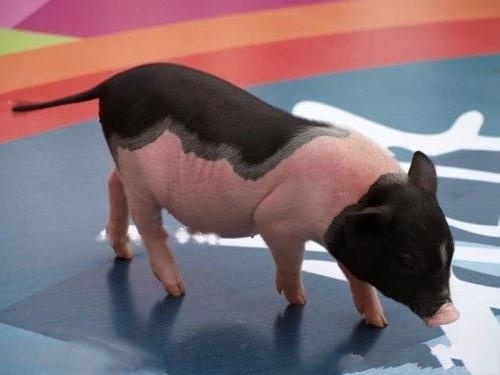Fragrant pigs are precocious and easy to fatten, with thin skin and thin bones, tender and juicy meat, rich aroma, no fishy smell of suckling pigs, and also fragrant when cooking without any seasoning. It is the best material for processing high-grade meat products and roasted milk. The preferred raw material for pigs. Fragrant pigs are resistant to rough feeding, have few diseases, and are easy to raise. They are suitable for farming by households in rural areas. What skills should we pay attention to when breeding pigs?

Xiangzhu
I. Economic Analysis of Breeding Fragrant Pigs
Characteristics of Fragrant Pigs:
The fragrant pig has the characteristics of small size, thin skin, tender meat, fine bone, early maturity and excellent meat quality. Medium-length, with longitudinal wrinkles on the forehead and face, various shapes, and small lotus-shaped ears. Slightly stretched forward and slightly drooping or stretched on both sides, the neck is short and thin, the back and waist are slightly concave, the abdomen is large, the sloping rump, the tail is long, the limbs are short and slender, the forelimb posture is correct, the hind limbs are lying on the pedicle, the sow nipples 5 more pairs. Congjiang and Huanjiang pigs have slightly different head shapes. Huanjiang pigs have larger heads, wide foreheads, short and thick mouths, and are slightly larger than Congjiang pigs.
Benefits of fragrant pig breeding:
Fragrant pig is resistant to roughage, has strong adaptability and is easy to manage, but grows slowly.
1. Tolerance to roughage: fragrant pigs are mainly free-range, and often eat green fodder such as weeds and fragrant rice, so that the suckling pork has a special fragrance. Each gilt (2-4 months old) On average, each head consumes 0.2kg of concentrated feed and 1kg of green feed per day. Pregnant and lactating sows consume an average of 0.4kg of concentrated feed and 2kg of green feed per day, which is less.
2. Strong adaptability: fragrant pigs have strong adaptability to the climate and rarely get sick, but fragrant pigs are timid and afraid of fear and are easy to escape, so they require a high pig pen and a quiet environment during feeding , the sports field should be larger.
3. Easy to manage: Xiang pigs have early sexual maturity, resistance to inbreeding, and stable heredity. When the boar weighs 8kg at 2 months of age, it will appear to have straddle behavior, and it will be bred at 3 months of age. Sows come into heat at 3 months of age and can be bred at 4 months of age, with an average of 7 to 10 litters per litter. The male to female ratio is 1:8 to 10.
4. Slow growth: The fragrant pig has the characteristics of rapid growth in the early stage, long side and fat side. 38kg. Generally, suckling pigs that are 5 to 7 weeks old are slaughtered, and slaughtering is the most suitable.
The skin is thin and the bone is thin, the meat is tender and delicious, and it is suitable for processing roasted suckling pigs. At the same time, it also has broad prospects as experimental animals or pets.
Second, matters needing attention in breeding pigs
1. Pay attention to the selection of pig species. When introducing pigs, the appearance, growth and development, pedigree, and the presence or absence of genetic defects of pig breeds should be strictly inspected. for future reference.
2. Pay attention to the local environment. The introduction of Dexiang pigs must meet the living consumption level and economic development needs of the local people. At the same time, it is necessary to understand the characteristics of species, climate, feeding management, etc., in order to determine the terroir domestication measures after the introduction of fragrant pigs, and create necessary feeding and management conditions, so as to ensure the breeding efficiency of fragrant pigs.
3. Pay attention to the season. It is best to introduce fragrant pigs in the late spring. After the warm summer, the autumn and winter seasons are spent with the temperature gradually decreasing, and it is required to do a good job of cold protection after the winter, and gradually adapt to the local natural conditions.
4. Pay attention to the age of the pigs. The introduction of fragrant pigs is best to introduce young pigs about 4 months old or slightly older. Pigs have strong adaptability at the young stage and are easy to accept the changed external living conditions. The pig breeds introduced at the beginning should not be fed in a scattered way, but should be concentrated in one or several pig farms to create good feeding and management conditions for feeding. At the same time, make good observation records, and do a good job in breeding and breeding work, and gradually promote them after adaptation. .
5. Pay attention to epidemic prevention and spread. When imported from other places, they should be kept in isolation for 1 to 2 months, strengthen epidemic prevention and disinfection, pay attention to eliminating and preventing the threat of endemic parasitic diseases and infectious diseases, and ensure the safety of introduced pig breeds.
![[Dog Training 5] The training method of pet dog dining etiquette](/static/img/12192/12192_1.jpg)




